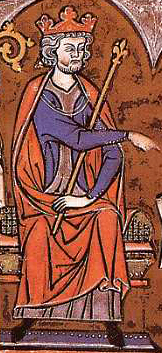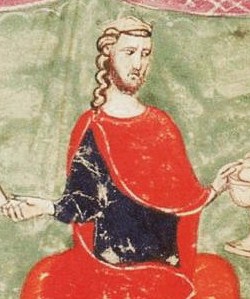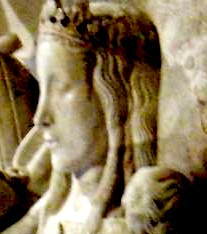
James I the Conqueror was King of Aragon and Lord of Montpellier from 1213 to 1276; King of Majorca from 1231 to 1276; and Valencia from 1238 to 1276 and Count of Barcelona. His long reign of 62 years is not only the longest of any Iberian monarch, but one of the longest monarchical reigns in history, ahead of Hirohito but remaining behind Queen Victoria and Ferdinand III of Naples and Sicily. He saw the expansion of the Crown of Aragon in three directions: Languedoc to the north, the Balearic Islands to the southeast, and Valencia to the south. By a treaty with Louis IX of France, he achieved the renunciation of any possible claim of French suzerainty over the County of Barcelona and the other Catalan counties, while he renounced northward expansion and taking back the once Catalan territories in Occitania and vassal counties loyal to the County of Barcelona, lands that were lost by his father Peter II of Aragon in the Battle of Muret during the Albigensian Crusade and annexed by the Kingdom of France, and then decided to turn south. His great part in the Reconquista was similar in Mediterranean Spain to that of his contemporary Ferdinand III of Castile in Andalusia. One of the main reasons for this formal renunciation of most of the once Catalan territories in Languedoc and Occitania and any expansion into them is the fact that he was raised by the Knights Templar crusaders, who had defeated his father fighting for the Pope alongside the French, so it was effectively forbidden for him to try to maintain the traditional influence of the Count of Barcelona that previously existed in Occitania and Languedoc.

Peter III of Aragon was King of Aragon, King of Valencia, and Count of Barcelona from 1276 to his death. At the invitation of some rebels, he conquered the Kingdom of Sicily and became King of Sicily in 1282, pressing the claim of his wife, Constance II of Sicily, uniting the kingdom to the crown.

Alfonso IX was King of León and Galicia from the death of his father Ferdinand II in 1188 until his own death.

Martin the Humane, also called the Elder and the Ecclesiastic, was King of Aragon, Valencia, Sardinia and Corsica and Count of Barcelona from 1396 and King of Sicily from 1409. He failed to secure the accession of his illegitimate grandson, Frederic, Count of Luna, and with him the rule of the House of Barcelona came to an end.

James II, called the Just, was the King of Aragon and Valencia and Count of Barcelona from 1291 to 1327. He was also the King of Sicily from 1285 to 1295 and the King of Majorca from 1291 to 1298. From 1297 he was nominally the King of Sardinia and Corsica, but he only acquired the island of Sardinia by conquest in 1324. His full title for the last three decades of his reign was "James, by the grace of God, king of Aragon, Valencia, Sardinia and Corsica, and count of Barcelona".

Alfonso of León, Lord of Molina was an infante (prince) of León and Castile, the son of King Alfonso IX of León and his second wife Queen Berengaria of Castile. He was the brother of King Ferdinand III of Castile and León, and father of Queen Maria of Molina, wife of King Sancho IV. He became Lord of Molina and Mesa after his first marriage to Mafalda González de Lara, the heiress of those lands.
Theresa of Portugal was Queen of Léon as the first wife of her first cousin King Alfonso IX of León. She was born the oldest daughter of Sancho I of Portugal and Dulce of Aragon. When her marriage was annulled because of consanguinity, she retired to a convent. She was beatified in 1705.
Maria of Portugal was a Portuguese infanta (princess) member of the House of Burgundy and by marriage Marchioness of Tortosa and Lady of Albarracín.
Violant of Hungary was the queen of Aragon from 1235 until 1251 as the second wife of King James I of Aragon. A member of the Hungarian House of Árpád, Queen Violant was a valuable and influential advisor of her husband. She remains in folk memory in Catalonia and Valencia.

Urraca of Castile was a daughter of Alfonso VIII of Castile and Eleanor of England. Her maternal grandparents were Henry II of England and Eleanor of Aquitaine.

María Alfonso Téllez de Meneses, known as María de Molina, was queen consort of Castile and León from 1284 to 1295 by marriage to Sancho IV of Castile, and served as regent for her minor son Ferdinand IV and later her grandson Alfonso XI of Castile (1312-1321).

Violant or Violante of Aragon, also known as Yolanda of Aragon, was Queen consort of Castile and León from 1252 to 1284 as the wife of King Alfonso X of Castile.

Violant of Bar was Queen of Aragon by marriage to John I of Aragon. She was active in matrimonial politics and served as regent of Aragon in the name of her spouse from 1388 until 1395.

Eleanor of Castile (1200—1244) was Queen of Aragon by her marriage to King James I of Aragon.

Martha of Armagnac was the youngest child of John I, Count of Armagnac, and his second wife Beatrice of Clermont. She was the first wife of John I of Aragon but never became Queen of Aragon because she was outlived by her father-in-law Peter IV of Aragon.
Beatrice of Castile was a daughter of Alfonso X of Castile and his wife Violant of Aragon. She was Marchioness of Montferrat by her marriage and was mother of Irene of Montferrat.

Diego López V de Haro, nicknamed el Intruso, was a Spanish noble of the House of Haro and held the title of the Lord of Biscay which he took from the pretender to the title, John of Castile.
Violant of Castile was infanta of Castile and Lady of Biscay on her marriage to Diego López V de Haro. She was the daughter of Alfonso X of Castile, and Violant of Aragon.

A conquest of Murcia took place in 1265–66 when James I of Aragon conquered the Muslim-held Taifa of Murcia on behalf of his ally Alfonso X of Castile.
Denis of Hungary, was a Hungarian-born Aragonese knight and nobleman in the 13th century. Born into a prominent family in the Kingdom of Hungary, he escorted Queen Violant of Hungary to the Kingdom of Aragon in 1235, where he settled down and faithfully served James I of Aragon during the Reconquista. Integrating into the local elite, Denis was the eponymous ancestor of the prominent Dionís (Dionisii) noble family. In Canals, Valencia, a street is named after him.














